气管插管(通常简称为插管)是一种侵入性医疗程序,是将柔性塑料导管置于气管中。几千年来,气管切开术被认为是最可靠(也是风险最大)的气管插管方法。到了19世纪后期,解剖学和生理学科学的进步,以及对疾病细菌理论的认识的开始,已经将这种手术的发病率和死亡率降低到更可接受的速度。同样在19世纪后期,内窥镜仪器的进步已经提高到这样的程度,即直接喉镜最终成为通过非手术气管路径确保气道的可行手段。直到20世纪初,鼻气管插管才得到广泛应用。 20世纪,气管切开术,内窥镜检查和非手术气管插管的实践从极少使用的手术转变为麻醉,重症监护医学,急诊医学,胃肠病学,肺病学和外科手术的基本组成部分。
目录
1 气管切开术
2 内镜
3 喉镜检查和非手术气管插管
4 21世纪
5 参考
气管切开术
另见:气管切开术
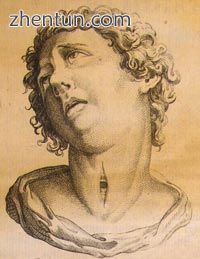
这幅肖像虽然没有注明日期,却支持了古代历史中气管切开术的观点
气管切开术最早的描述可以追溯到大约公元前3600年的两块埃及药片上。[1] 110页的Ebers Papyrus是埃及医学纸莎草,可追溯到公元前1550年左右,也指气管切开术。[1] [2]古老的印度经文Rigveda描述了气管切开术:文中提到“如果没有完全切断宫颈软骨被切断的话,那些没有结扎线的人可以使气管重新团结起来。”[ 2] [3] [4] Sushruta Samhita(大约公元前400年)是印度次大陆关于阿育吠陀医学和外科手术的另一篇提到气管切开术的文章。[5]
希腊医生希波克拉底(约公元前460年 - 约公元前370年)谴责气管切开术的做法。 Hippocrates警告说,在气管切开术期间,由于颈动脉无意中撕裂造成不可接受的死亡风险,因此“最困难的瘘管是在软骨区域发生的瘘管。”[6] Byzantium的Homerus据说是亚历山大的写作伟大的(公元前356-323)通过在男人的气管中用剑尖切开拯救士兵免于窒息。[7]
尽管希波克拉底的担忧,佩加蒙的盖伦(129-199)和卡帕多西亚的阿雷泰乌斯(他们都在公元2世纪住在罗马)都认为比西尼亚的Asclepiades(约公元前124-40)是第一位执行的医生。非急诊气管切开术。[8] [9]然而,Aretaeus警告不要进行气管切开术,因为他认为气管软骨切口容易发生继发性伤口感染,因此无法愈合。他写道:“伤口的嘴唇不合并,因为它们都是软骨的而不是团结的性质”。[10] [11]另一位希腊外科医生Antyllus于公元2世纪住在罗马,据报道在治疗口腔疾病时进行了气管切开术。他将该技术改进为与现代使用的技术更相似,建议在第三和第四气管环之间进行横切口,以治疗危及生命的气道阻塞。[10] Antyllus写道,气管切开术在严重喉气管支气管炎的情况下无效,因为病理位于手术部位的远端。 Antyllus的原始著作丢失了,但是Oribasius(约320-400)和Aegina的保罗(约625-690)保留了他们,他们都是希腊医生和历史学家。[10]盖伦澄清了气管的解剖结构,并且是第一个证明喉部产生声音的人。[12] [13]盖伦可能已经理解了人工通气的重要性,因为在他的一项实验中,他用波纹管给死去的动物的肺部充气。[14] [15]
在中世纪,欧洲大部分地区的科学发现很少见。然而,科学文化在世界其他地区蓬勃发展。 1000年,居住在安达卢斯的阿拉伯人阿卡·卡西姆·扎拉维(936-1013)发表了30卷的Kitab al-Tasrif,这是第一部关于外科手术的插图。他从未进行气管切开术,但他确实治疗了一名自杀未遂的奴隶女孩。 Al-Zahrawi(欧洲人称为Albucasis)缝合伤口,女孩康复,从而证明喉部的切口可以愈合。大约1020年,IbnSīnā(980-1037)描述了在“医学佳能”中使用气管插管来促进呼吸。[16]在12世纪的医学教科书Al-Taisir中,Al-Andalus的Ibn Zuhr(1091-1161)(也称为Avenzoar)提供了气管切开手术的解剖学正确描述。[17] [18]
文艺复兴在解剖学和外科学方面取得了重大进展,外科医生对气管手术越来越开放。尽管如此,死亡率仍未得到改善。[10]从1500年到1832年,文献中只有28种已知的成功气管切开术描述。[10]关于气管插管和随后的动物人工呼吸的第一次详细描述来自布鲁塞尔的Andreas Vesalius(1514-1564)。在他1543年出版的具有里程碑意义的著作“De humani corporis fabrica”中,他描述了一个实验,他将芦苇传递到一只垂死的动物的气管中,胸部已经打开并通过间歇地吹入芦苇保持通气。[15] [19] ] Vesalius写道,这项技术可以挽救生命。患者被理发外科医生拒绝后,费拉拉的Antonio Musa Brassavola(1490-1554)通过气管切开术治疗患有扁桃体周围脓肿的患者。患者显然完全康复,Brassavola在1546年公布了他的账户。尽管许多古老的气管引用并且可能开放,但这项手术已被确定为首次记录成功的气管切开术。[10]
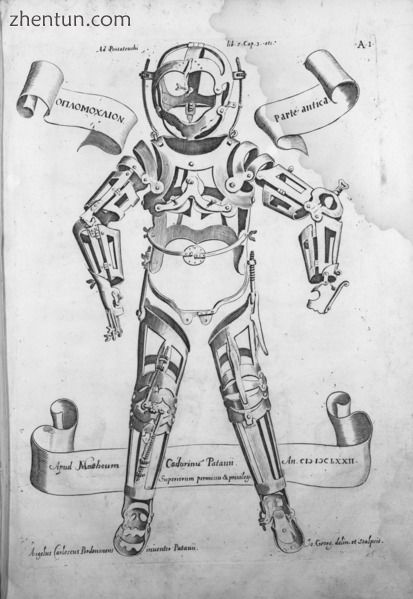
Hieronymus Fabricius,Operationes chirurgicae,1685
在16世纪末,解剖学家和外科医生Hieronymus Fabricius(1533-1619)在他的著作中描述了一种有用的气管切开术技术,尽管他自己从未实际进行手术。他建议使用垂直切口,并且是第一个引入气管造口管的想法。这是一个直的,短的插管,包含翅膀,以防止管进入气管太远。 Fabricius对气管切开术的描述与今天使用的相似。 Julius Casserius(1561-1616)接替了Fabricius担任帕多瓦大学解剖学教授,并发表了他自己关于气管切开技术和设备的著作,推荐了一个带有多个孔的弯曲银管。 Marco Aurelio Severino(1580-1656)是一位熟练的外科医生和解剖学家,他使用Fabricius推荐的垂直切口技术,于1610年在那不勒斯的白喉疫情期间进行了多次成功的气管切开术。他还开发了自己的套管针版本。[20]
1620年,法国外科医生尼古拉斯·哈比科特(1550-1624),内穆尔公爵和解剖学家的外科医生,发表了他所做的四次成功“支气管切开术”的报告。[21]其中之一是首次记录的气管切开术,用于切除异物,在这种情况下是刺伤受害者喉部的血凝块。他还描述了第一例已在儿科患者身上进行的气管切开术。一名14岁的男孩吞下一个装有9枚金币的袋子,试图防止一名劫匪盗窃。这个物体落入他的食道,阻塞了他的气管。 Habicot建议该手术对于患有喉部炎症的患者也可能有效。他为这种外科手术开发了与现代设计相似的设备。
Sanctorius(1561-1636)被认为是第一个在手术中使用套管针的人。他建议在手术后几天将插管留在原位。[22]早期的气管切开术装置在Habicot的问题Chirurgicale [21]和Julius Casserius的遗腹Tabulae anatomicae在1627年进行了说明。[23]鲁汶大学医学教授Thomas Fienus(1567-1631)是第一个在1649年使用“气管切开术”一词的人,但这个术语直到一个世纪后才被普遍使用。[24]罗斯托克大学解剖学教授Georg Detharding(1671-1747)于1714年对一名溺水的受害者进行了气管切开术治疗。[25] [26] [27]
尽管知道到那时已经发生了不可逆的器官损害,但大多数外科医生都害怕并发症,推迟了可能挽救生命的气管切开术直到病人奄奄一息。这种情况在19世纪初开始发生变化,当时气管切开术最终开始被认为是治疗严重气道阻塞的合法手段。 1832年,法国医生Pierre Bretonneau(1778-1862)采用气管切开术作为治疗白喉病的最后手段。[28] 1852年,Bretonneau的学生Armand Trousseau(1801-1867)展示了169个气管切开术系列(其中158个用于哮喘,11个用于“喉部慢性疾病”)。[29] 1871年,德国外科医生Friedrich Trendelenburg(1844-1924)发表了一篇论文,描述了第一次成功进行人体气管切开术以进行全身麻醉。[30] [31] [32] [33] 1888年德国皇帝弗雷德里克三世死于喉癌后,莫雷尔·麦肯齐爵士(1837-1892)和其他治疗医师共同撰写了一本书,讨论当时气管切开术的适应证以及手术何时绝对必要。[34]
在20世纪初,医生开始使用气管切开术治疗患有需要机械通气的麻痹性脊髓灰质炎患者。目前使用的外科气管切开术技术于1909年由费城杰斐逊医学院的喉科学教授Chevalier Jackson(1865-1958)描述。[35]然而,外科医生继续在20世纪对气管切开术的各个方面进行辩论。采用了许多技术,以及许多不同的手术器械和气管导管。外科医生似乎无法就气管切口的位置或方式达成共识,认为“高气管切开术”或“低气管切开术”是否更有益。具有讽刺意味的是,新开发的吸入麻醉剂和全身麻醉技术实际上似乎增加了风险,许多患者患有致命的术后并发症。杰克逊强调了术后护理的重要性,这大大降低了死亡率。到1965年,外科解剖被广泛和广泛地了解,抗生素广泛可用并且可用于治疗术后感染和气管切开术的其他主要并发症也变得更易于控制。
内镜
另见:内窥镜检查
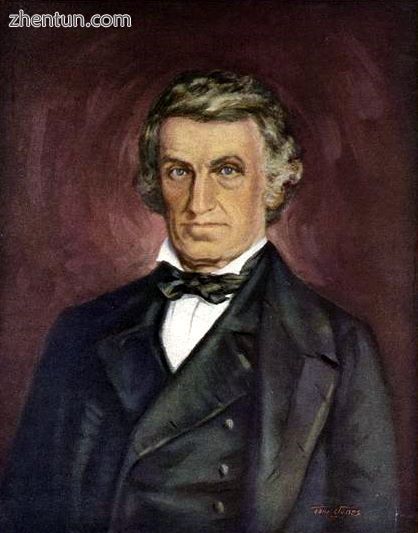
William Beaumont(1785-1853),美国生理学家
虽然所有这些手术都在进行,但光学科学也发生了许多重要的发展。许多具有医疗应用的新型光学仪器是在19世纪发明的。 1805年,一位名叫Philipp von Bozzini(1773-1809)的德国军队外科医生发明了一种他称之为lichtleiter(或光导仪器)的装置。该仪器是现代内窥镜的祖先,用于检查尿道,人膀胱,直肠,口咽和鼻咽。[36] [37] [38] [39]该仪器由金属烟囱内的蜡烛组成;内部的镜子反射来自蜡烛的光线通过附件进入相关的体腔。[40]在人类胃镜检查的做法是由美国陆军外科医生威廉博蒙特(1785年至1853年)于1822年率先与他的病人亚历克西斯圣马丁(1794年至1880年),一个偶然的枪伤胃的受害者的合作。 [41] 1853年,巴黎的Antonin Jean Desormeaux(1815-1882)修改了Bozzini的lichtleiter,使得镜子能够通过长金属通道反射来自煤油灯的光线。[40]将这种仪器称为内窥镜(他称之为创造这个术语),Desormeaux用它来检查膀胱。然而,就像Bozzini的lichtleiter一样,Desormeaux的内窥镜由于在使用过程中变得非常热,所以效用有限。[40] 1868年,德国的阿道夫·库斯马尔(Adolph Kussmaul,1822-1902)对一个活着的人进行了第一次食管胃十二指肠镜检查(一种内窥镜用于显示食道,胃和十二指肠的诊断程序)。受试者是一个吞剑的人,他吞下了一根长47厘米,直径13毫米的金属管。[42] [43] [44] [45]于1877年10月2日,柏林泌尿科医师马西米兰卡尔 - 弗里德里希尼兹(1848年至1906年)和维也纳仪器制造者约瑟夫雷特(1830至1892年)介绍了第一个实用cystourethroscope有电光源。[46]该仪器的最大缺点是钨丝白炽灯泡(由亚历山大Lodygin发明,1847-1923),它变得非常热,需要复杂的水冷却系统。[40] 1881年,波兰医生Jan Mikulicz-Radecki(1850-1905)创建了第一台用于实际应用的刚性胃镜。[47] [48] [49]
1932年,德国的Rudolph Schindler(1888-1968)推出了第一台半柔性胃镜。[50]该装置在整个管中放置了许多透镜,在远端尖端有一个微型灯泡。该装置的管长75厘米,直径11毫米,远端部分能够有一定程度的屈曲。 1945年至1952年间,光学工程师(特别是德国Karl Storz GmbH公司的Karl Storz(1911-1996),英国的Harold Hopkins(1918-1995)和日本奥林巴斯公司的Mutsuo Sugiura)在这项早期工作的基础上,领先开发第一个“gastrocamera”。[51] [52] 1964年,葡萄牙的费尔南多·阿尔维斯·马丁斯(Fernando Alves Martins,1927年6月17日出生)将光纤技术应用于其中一个早期的胃镜中,用柔性纤维镜生产出第一个胃镜。[53] [54]最初用于食管胃十二指肠镜检查的新型装置在20世纪60年代后期开发用于支气管镜检查,鼻镜检查和喉镜检查。 1967年,英国麻醉师Peter Murphy介绍了使用光纤内窥镜进行气管插管的概念。[55]到20世纪80年代中期,柔性纤维支气管镜已成为肺病学和麻醉学界不可或缺的工具。[56]
喉镜检查和非手术气管插管
另见:气管插管
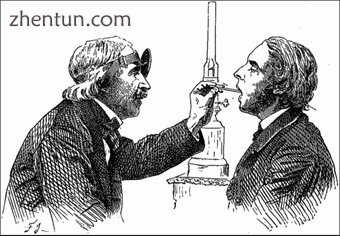
喉镜检查。 来自加西亚,1884年
法国儿科医生EugèneBouchut
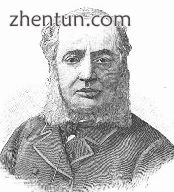
由Henri Brauer雕刻法国儿科医生EugèneBouchut。
来自Angelo Mariani和Joseph Uzanne(1894)。同时代表了Tiréesdel'Album Mariani,第一卷。巴黎:Ernest Flammarion。
1854年,一位名叫曼努埃尔·加西亚(1805-1906)的西班牙声乐教师成为第一个在活着的人类中观察功能性声门的人。加西亚开发了一种工具,使用了两个镜子,太阳作为外部光源。[57]使用这种装置,他能够观察到他自己的声门装置和气管最上部的功能。他于1855年在伦敦皇家学会上发表了他的观察结果。[57] [58]
1858年,来自巴黎的儿科医生EugèneBouchut(1818-1891)开发了一种新的非手术气管插管技术,以绕过由白喉相关的假膜引起的喉部阻塞。他的方法是将一根直的小金属管插入喉部,用丝线固定,并在那里放置几天,直到假膜和气道阻塞得到充分解决。[59] Bouchut介绍了这种实验技术以及他在1858年9月18日法国科学院会议的前七个案例中取得的成果。[60]学院的成员拒绝了Bouchut的想法,主要是由于有影响力的Armand Trousseau做出的高度批评性和负面评论。[61] Bouchut毫无畏惧地推出了一套用于气管插管的管(“Bouchut管”),作为白喉病例气管切开术的替代方案。
1878年3月,Freiburg的Wilhelm Hack发表了一篇论文,描述了非手术气管插管在拔除声带息肉中的应用。[62]那年11月,他发表了另一项研究,这次是使用经口气管插管来确保患有急性声门水肿的患者的气道,逐渐将“Schrotter's Graduated triangle vulcanite bougies”的尺寸3到11引入喉部。 63] [64] 1880年,苏格兰外科医生William Macewen(1848-1924)报道了他使用经口气管插管作为气管切开术的替代方法,以使患有声门水肿的患者能够呼吸,以及使用氯仿进行全身麻醉。[64] [65] [66]之前对声门和喉部(包括García,Hack和Macewen)的所有观察都是在间接视觉下(使用镜子)进行的,直到1895年4月23日,当时德国的Alfred Kirstein(1863-1922)首次描述了声乐的直接可视化线。 Kirstein在柏林进行了第一次直接喉镜检查,使用他为此目的修改的食道镜;他把这台设备称为一台验尸仪。[67] 1888年皇帝弗雷德里克三世[34]的死亡可能促使基尔斯坦开发了验尸仪。[68]
直到1913年,口腔和颌面外科手术通过面罩吸入麻醉,局部麻醉剂局部应用于粘膜,直肠麻醉或静脉麻醉进行。虽然有效,但这些技术不能保护气道免受阻塞,并且还使患者暴露于肺部吸入血液和粘液进入气管支气管树的风险。 1913年,Chevalier Jackson是第一个报告使用直接喉镜作为插管气管的手段成功率很高的人。[69]杰克逊推出了一种新的喉镜刀片,它在远端尖端有一个光源,而不是Kirstein使用的近端光源。[70]这种新刀片包含一个操作员可以滑出的部件,以便为气管导管或支气管镜的通过留出空间。[71]
同年,Henry H. Janeway(1873-1921)公布了他最近开发的喉镜取得的成果。[72] Janeway是一位在纽约市Bellevue医院执业的美国麻醉师,他认为直接气管内注入挥发性麻醉剂可以为耳鼻喉科手术提供更好的条件。考虑到这一点,他开发了一种专为气管插管而设计的喉镜。与Jackson的设备类似,Janeway的仪器包含远端光源。然而,独特的是在手柄内包含电池,叶片中的中央凹口用于在插管期间将气管导管保持在口咽的中线,并且与刀片的远端尖端略微弯曲以帮助引导管穿过声门。这种设计的成功导致其随后用于其他类型的手术。因此,Janeway在推广麻醉学实践中广泛使用直接喉镜和气管插管方面发挥了重要作用。[68]
第一次世界大战后,在气管内麻醉领域取得了进一步的进展。其中包括Ivan Whiteside Magill爵士(1888-1986)制作的那些。与整形外科医生Harold Gillies爵士(1882-1960)和麻醉师E. Stanley Rowbotham(1890-1979)一起在Sidcup女王医院做面部和颌骨损伤,Magill开发了清醒盲鼻气管插管技术。[73] [74] ] [75] [76] [77] [78] Magill设计了一种新型的成角钳(Magill镊子),目前仍在使用这种镊子以促进鼻气管插管,其方式与Magill的原始技术相比几乎没有变化。[79] Magill发明的其他装置包括Magill喉镜刀片,[80]以及几种用于挥发性麻醉剂给药的装置。[81] [82] [83]气管导管的Magill曲线也以Magill命名。
罗伯特雷诺兹麦克斯爵士(1897-1989)在1943年推出他的新型弯曲喉镜刀片时,也在气管插​​管技术方面取得了重大进展。[84] Macintosh刀片至今仍是用于经口气管插管的最广泛使用的喉镜刀片。[85] 1949年,Macintosh发表了一份病例报告,描述了牙龈弹性导尿管作为气管插管导管的新用途,以促进气管插管困难。[86]受Macintosh报告的启发,P. Hex Venn(当时是英国公司Eschmann Brothers&Walsh,Ltd。的麻醉顾问)着手开发一种基于这一概念的气管导管导引器。维恩的设计于1973年3月被接受,而后来被称为埃施曼气管内导管的人将于今年晚些时候投入生产。[87]维恩设计的材料与胶弹性探针的材料不同,它具有两层:由聚酯线编织的管芯和外树脂层。这提供了更大的刚度,但保持了柔韧性和光滑的表面。其他差异是长度(新的导入器是60厘米(24英寸),比胶弹性探针长得多)和35°弯曲尖端的存在,让它在障碍物周围转向。[88] [89]使用管心针替换或交换经口管的概念由Finucane和Kupshik在1978年使用中心静脉导管引入。[90]
21世纪
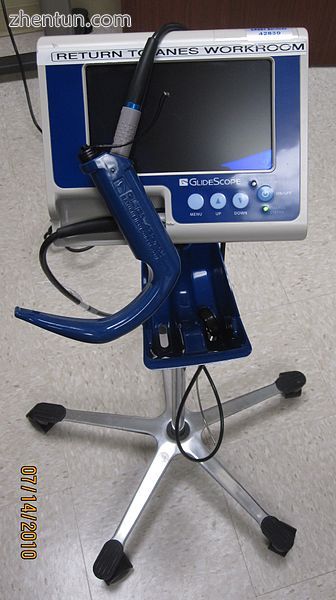
Glidescope视频喉镜,内置CMOS有源像素传感器(CMOS APS)摄像头和高分辨率LCD监视器
20世纪,气管切开术,内窥镜检查和非手术气管插管的实践从极少使用的手术转变为麻醉,重症监护医学,急诊医学,胃肠病学,肺病学和外科手术的基本组成部分。 21世纪的“数字革命”为气管插管的艺术和科学带来了更新的技术。 一些制造商开发了使用数字技术的视频喉镜,例如CMOS有源像素传感器(CMOS APS),以产生声门的视图,从而可以插管气管。 Glidescope视频喉镜就是这种设备的一个例子。[91] [92]
另见
History portal
icon Medicine portal
History of anatomy
History of general anesthesia
History of medicine
History of surgery
参考
General
American College of Surgeons Committee on Trauma (2004). ATLS: Advanced Trauma Life Support Program for Doctors (7th ed.). Chicago, Illinois: American College of Surgeons. ISBN 978-1-880696-31-6. Retrieved 6 September 2010.
Barash, PG; Cullen, BF; Stoelting, RK, eds. (2009). Clinical Anesthesia (6th ed.). Philadelphia: Lippincott Williams & Wilkins. ISBN 978-0-7817-8763-5. Retrieved 6 September 2010.
Benumof, JL, ed. (2007). Benumof's Airway Management: Principles and Practice (2nd ed.). Philadelphia: Mosby-Elsevier. ISBN 978-0-323-02233-0. Retrieved 6 September 2010.
Classen, M, ed. (2002). Gastroenterological endoscopy (1st ed.). Stuttgart, Germany: Georg Thieme Verlag. ISBN 978-1-58890-013-5. Retrieved 6 September 2010.
Doherty, GM, ed. (2010). Current Diagnosis & Treatment: Surgery (13th ed.). McGraw-Hill Medical. ISBN 978-0-07-163515-8. Retrieved 6 September 2010.
Levitan, RM (2004). The Airway Cam Guide to Intubation and Practical Emergency Airway Management (1st ed.). Wayne, PA: Airway Cam Technologies. ISBN 978-1-929018-12-3. Retrieved 6 September 2010.
Miller, RD, ed. (2000). Anesthesia, Volume 1 (5th ed.). Philadelphia: Churchill Livingstone. ISBN 978-0-443-07995-5. Retrieved 6 September 2010.
Vilardell, Francisco (2006). Digestive endoscopy in the second millennium: from the lichtleiter to echoendoscopy. Stuttgart, Germany: Georg Thieme Verlag. ISBN 978-3-13-139671-6. Retrieved 15 September 2010.
Specific
Pahor, Ahmes L. (2007). "Ear, Nose and Throat in Ancient Egypt". The Journal of Laryngology & Otology. 106 (8): 677–87. doi:10.1017/S0022215100120560. PMID 1402355.
Frost, EA (1976). "Tracing the tracheostomy". Annals of Otology, Rhinology, and Laryngology. 85 (5 Pt.1): 618–24. doi:10.1177/000348947608500509. PMID 791052.
Stock, CR (1987). "What is past is prologue: a short history of the development of tracheostomy". Ear, Nose, & Throat Journal. 66 (4): 166–9. PMID 3556136.
Pahor, Ahmes L. (2007). "Ear, Nose and Throat in Ancient Egypt". The Journal of Laryngology & Otology. 106 (9): 773–9. doi:10.1017/S0022215100120869.
Sushruta (1907). "Introduction". In Kaviraj Kunja Lal Bhishagratna (ed.). Sushruta Samhita, Volume1: Sutrasthanam. Calcutta: Kaviraj Kunja Lal Bhishagratna. pp. iv. Retrieved 6 September 2010.
Jones, W. H. S. (2009). "Hippocrates in English". The Classical Review. 2 (2): 88–9. doi:10.1017/S0009840X00158688.
Szmuk, Peter; Ezri, Tiberiu; Evron, Shmuel; Roth, Yehudah; Katz, Jeffrey (2007). "A brief history of tracheostomy and tracheal intubation, from the Bronze Age to the Space Age". Intensive Care Medicine. 34 (2): 222–8. doi:10.1007/s00134-007-0931-5. PMID 17999050.
Gumpert, CG (1794). "Cap. VIII: de morborum cognitione et curatione secundum Asclepiadis doctrinam". Asclepiadis Bithyniae Fragmenta (in Latin). Weimar: Industrie-Comptoir. pp. 133–84. Retrieved 6 September 2010.
Yapijakis, C (2009). "Hippocrates of Kos, the father of clinical medicine, and Asclepiades of Bithynia, the father of molecular medicine. Review". In Vivo. 23 (4): 507–14. PMID 19567383. Retrieved 6 September 2010.
Goodall, EW (1934). "The story of tracheostomy". British Journal of Children's Diseases. 31: 167–76, 253–72.
Grillo, H (2003). "Development of tracheal surgery: a historical review. Part 1: techniques of tracheal surgery". Annals of Thoracic Surgery. 75 (2): 610–9. doi:10.1016/S0003-4975(02)04108-5. PMID 12607695.
Galeni Pergameni, C (1956). Galen on anatomical procedures: De anatomicis administrationibus. Edited and translated by Singer CJ. London: Geoffrey Cumberlege, Oxford University Press/Wellcome Historical Medical Museum. pp. 195–207. See also: "Galen on Anatomical Procedures: De Anatomicis Administrationibus". JAMA. 162 (6): 616. 1956. doi:10.1001/jama.1956.02970230088033.
"Galen on Anatomical Procedures". Proceedings of the Royal Society of Medicine. 49 (10): 833. 1956. PMC 1889206.
Galeni Pergameni, C (1528). "De usu partium corporis humani, libri VII, cap. IV". In Nicolao Regio Calabro (Nicolaus Rheginus) (eds.). De usu partium corporis humani, libri VII (in Latin). Paris: Simonis Colinaei. p. 339. Retrieved 6 September 2010.
Baker, A. Barrington (1971). "Artificial respiration, the history of an idea". Medical History. 15 (4): 336–51. doi:10.1017/s0025727300016896. PMC 1034194. PMID 4944603.
Skinner, P (2008). "Unani-tibbi". In Laurie J. Fundukian (ed.). The Gale Encyclopedia of Alternative Medicine (3rd ed.). Farmington Hills, Michigan: Gale Cengage. ISBN 978-1-4144-4872-5. Retrieved 6 September 2010.
Abdel-Halim, RE (2005). "Contributions of Ibn Zuhr (Avenzoar) to the progress of surgery: a study and translations from his book Al-Taisir". Saudi Med J. 26 (9): 1333–9. PMID 16155644. Retrieved 6 September 2010.
Shehata, M (2003). "The Ear, Nose and Throat in Islamic Medicine" (PDF). Journal of the International Society for the History of Islamic Medicine. 2 (3): 2–5. Retrieved 6 September 2010.
Vesalius, A (1543). "Cap. XIX-De vivorum sectione nonniulla". De humani corporis fabrica, Libri VII (in Latin). Basel: Johannes Oporinus. pp. 658–63. Retrieved 6 September 2010.
"Nova et Vetera". BMJ. 1 (5179): 1129–30. 1960. doi:10.1136/bmj.1.5179.1129. PMC 1966956.
Habicot, N (1620). Question chirurgicale par laquelle il est démonstré que le chirurgien doit assurément practiquer l'operation de la bronchotomie, vulgairement dicte laryngotomie, ou perforation de la fluste ou du polmon (in French). Paris: Corrozet. p. 108.
Sanctorii S (1646). Sanctorii Sanctorii Commentaria in primum fen, primi libri canonis Avicennæ (in Latin). Venetiis: Apud Marcum Antonium Brogiollum. p. 1120. OL 15197097M. Retrieved 6 September 2010.
Casserius (Giulio Casserio), J; Bucretius, D (1632). Tabulae anatomicae LXXIIX ... Daniel Bucretius ... XX. que deerant supplevit & omnium explicationes addidit (in Latin). Francofurti: Impensis & coelo Matthaei Meriani. Retrieved 6 September 2010.
Cawthorne, T; Hewlett, AB; Ranger, D (1959). "Discussion: Tracheostomy To-Day". Proceedings of the Royal Society of Medicine. 52 (6): 403–5. PMC 1871130. PMID 13667911.
Detharding, G (1745). "De methodo subveniendi submersis per laryngotomiam (1714)". In Von Ernst Ludwig Rathlef; Gabriel Wilhelm Goetten; Johann Christoph Strodtmann (eds.). Geschichte jetzlebender Gelehrten, als eine Fortsetzung des Jetzlebenden (in Latin). Zelle: Berlegts Joachim Undreas Deek. p. 20. Retrieved 6 September 2010.
Wischhusen, HG; Schumacher, GH (1977). "Curriculum vitae of the professor of anatomy, botany and higher mathematics Georg Detharding (1671–1747) at the University of Rostock". Anat Anz (in German). 142 (1–2): 133–40. PMID 339777.
Price, JL (1962). "THE EVOLUTION OF BREATHING MACHINES". Medical History. 6 (1): 67–72. doi:10.1017/s0025727300026867. PMC 1034674. PMID 14488739.
Trousseau, A (1833). "Mémoire sur un cas de tracheotomie pratiquée dans la période extrème de croup". Journal des Connaissances Médico-chirurgicales (in French). 1 (5): 41.
Trousseau, A (1852). "Nouvelles recherches sur la trachéotomie pratiquée dans la période extrême du croup". Annales de Médecine Belge et étrangère (in French). 1: 279–88. Retrieved 6 September 2010.
Trendelenburg, F (1871). "Beiträge zu den Operationen an den Luftwegen" [Contributions to airways surgery]. Archiv für Klinische Chirurgie (in German). 12: 112–33.
Hargrave, R (1934). "ENDOTRACHEAL ANÆSTHESIA IN SURGERY OF THE HEAD AND NECK". Canadian Medical Association Journal. 30 (6): 633–7. PMC 403396. PMID 20319535.
Bain, J A; Spoerel, W E (1964). "Observation on the use of cuffed tracheqstomy tubes (with particular reference to the james tube)". Canadian Anaesthetists' Society Journal. 11 (6): 598–608. doi:10.1007/BF03004104. PMID 14232175.
Wawersik, Juergen (1991). "History of Anesthesia in Germany". Journal of Clinical Anesthesia. 3 (3): 235–44. doi:10.1016/0952-8180(91)90167-L. PMID 1878238.
Mackenzie, M (1888). The case of Emperor Frederick III.: full official reports by the German physicians and by Sir Morell Mackenzie. New York: Edgar S. Werner. p. 276. Retrieved 6 September 2010.
Jackson, Chevalier (1909). "Tracheotomy". The Laryngoscope. 19 (4): 285–90. doi:10.1288/00005537-190904000-00003.
Bozzini, P (1806). "Lichtleiter, eine Erfindung zur Anschauung innerer Theile und Krankheiten nebst der Abbildung". J Practischen Heilkunde Berlin (in German). 24: 107–24.
Bozzini, P (1810). "Lichtleiter, eine Erfindung zur Anschauung innerer Theile und Krankheiten nebst der Abbildung". Heidelbergische Jahrbücher der Litteratur (in German). 3. Heidelberg: bey Wöhr und Zimmer. p. 207. Retrieved 6 September 2010.
Bush, R; Leonhardt, H; Bush, I; Landes, R (1974). "Dr. Bozzini's Lichtleiter: A translation of his original article (1806)". Urology. 3 (1): 119–23. doi:10.1016/S0090-4295(74)80080-4. PMID 4591409.
Pearlman, SJ (1949). "Bozzini's classical treatise on endoscopy: a translation". Quart Bull Northwest Univ Med School. 23: 332–54.
Engel, R (2007). "Development of the Modern Cystoscope: An Illustrated History". Medscape Urology. Retrieved 6 September 2010.
Beaumont, W; Combe, A (1838). Experiments and observations on the gastric juice, and the physiology of digestion (reprint ed.). Edinburgh: MacLachlan & Stewart. ISBN 978-0-486-69213-5. Retrieved 6 September 2010.
Killian, Gustvan (1911). "The history of bronchoscopy and esophagoscopy". The Laryngoscope. 21 (9): 891–7. doi:10.1288/00005537-191109000-00001.
Modlin, I. M.; Kidd, M; Lye, KD (2004). "From the Lumen to the Laparoscope". Archives of Surgery. 139 (10): 1110–26. doi:10.1001/archsurg.139.10.1110. PMID 15492154.
Elewaut, A; Cremer, M (2002). "The History of Gastrointestinal Endoscopy—The European Perspective". In Meinhard Classen et al. (eds.). Gastroenterological endoscopy (1st ed.). Stuttgart, Germany: Georg Thieme Verlag. p. 17. ISBN 978-1-58890-013-5. Retrieved 6 September 2010. Explicit use of et al. in: |editors= (help)
Vilardell, F (2006). "Rigid gastroscopes". Digestive Endoscopy in the Second Millennium: From the Lichtleiter to Echoendoscopy. Stuttgart, Germany: Georg Thieme Verlag. pp. 32–5. ISBN 978-3-13-139671-6. Retrieved 25 January 2013.
Mouton, Wolfgang G.; Bessell, Justin R.; Maddern, Guy J. (1998). "Looking Back to the Advent of Modern Endoscopy: 150th Birthday of Maximilian Nitze". World Journal of Surgery. 22 (12): 1256–8. doi:10.1007/s002689900555. PMID 9841754.
Mikulicz-Radecki, J (1881). "über Gastroskopie und Ösophagoskopie". Wiener Medizinische Presse (in German). 22: 1405–8, 1437–43, 1473–5, 1505–7, 1537–41, 1573–7, 1629–31.
Schramm, H; Mikulicz-Radecki, J (1881). "Gastroskopia i ezofagoskopia" [Gastroscopy and oesophagoscopy]. Przegla̧d Lekarski (in Polish). 20: 610.
Kielan, Wojciech; Lazarkiewicz, Bogdan; Grzebieniak, Zygmunt; Skalski, Adam; Zukrowski, Piotr (2005). "Jan Mikulicz-Radecki: one of the creators of world surgery". The Keio Journal of Medicine. 54 (1): 1–7. doi:10.2302/kjm.54.1. PMID 15832074.
Schäfer, P K; Sauerbruch, T (2004). "Rudolf Schindler (1888–1968) – 'Vater' der Gastroskopie" [Rudolf Schindler (1888–1968) – 'Father' of Gastroscopy]. Zeitschrift für Gastroenterologie (in German). 42 (6): 550–6. doi:10.1055/s-2004-813178. PMID 15190453.
‹See Tfd›US 2641977, ‹See Tfd›Tatsuro Uji, Mutsuo Sugiura and Shoji Fukami, "Camera for taking photographs of inner wall of cavity of human or animal bodies", issued June 16, 1953
"History of endoscopes. Volume 2: Birth of gastrocameras". Olympus Corporation. 2010. Retrieved 6 September 2010.
"History of endoscopes. Volume 3: Birth of fiberscopes". Olympus Corporation. 2010. Retrieved 6 September 2010.
Martins, FA (2009). "O Endoscópio". Fernando Alves Martins: A vida e a obra de um homem discreto. Inventor, compositor, curioso, um homem à frente do seu tempo (in Portuguese). Retrieved 6 September 2010.
Murphy, Peter (1967). "A fibre?optic endoscope used for nasal intubation". Anaesthesia. 22 (3): 489–91. doi:10.1111/j.1365-2044.1967.tb02771.x. PMID 4951601.
Wheeler M and Ovassapian A, "Fiberoptic endoscopy-aided technique", Chapter 18, p. 423 in Benumof (2007)
Garcia, Manuel (1854). "Observations on the Human Voice". Proceedings of the Royal Society. 7: 399–410. doi:10.1098/rspl.1854.0094.
Radomski, T (2005). "Manuel García (1805–1906):A bicentenary reflection" (PDF). Australian Voice. 11: 25–41. Retrieved 6 September 2010.
Bouchut, E (1858). "D'une nouvelle méthode de traitement du croup par le tubage du larynx" [On a new method of treatment for croup by larynx intubation]. Bulletin de l'Académie Impériale de Médecine (in French). 23: 1160–2. Retrieved 6 September 2010.
Sperati, G; Felisati, D (2007). "Bouchut, O'Dwyer and laryngeal intubation in patients with croup". Acta Otorhinolaryngolica Italica. 27 (6): 320–3. PMC 2640059. PMID 18320839.
Trousseau, A (1858). "Du tubage de la glotte et de la trachéotomie" [On intubation of the glottis and tracheotomy]. Bulletin de l'Académie Impériale de Médecine (in French). 23.
Hack, W (1878). "über einen fall endolaryngealer exstirpation eines polypen der vorderen commissur während der inspirationspause". Berliner Klinische Wochenschrift (in German): 135–7. Retrieved 6 September 2010.
Hack, W (1878). "über die mechanische Behandlung der Larynxstenosen" [On the mechanical treatment of laryngeal stenosis]. Sammlung Klinischer Vorträge (in German). 152: 52–75.
MacEwen, W. (1880). "Clinical Observations on the Introduction of Tracheal Tubes by the Mouth, Instead of Performing Tracheotomy or Laryngotomy". BMJ. 2 (1022): 163–5. doi:10.1136/bmj.2.1022.163. PMC 2241109. PMID 20749636.
MacEwen, W. (1880). "General Observations on the Introduction of Tracheal Tubes by the Mouth, Instead of Performing Tracheotomy or Laryngotomy". BMJ. 2 (1021): 122–4. doi:10.1136/bmj.2.1021.122. PMC 2241154. PMID 20749630.
MacMillan, Malcolm (2010). "William Macewen [1848–1924]". Journal of Neurology. 257 (5): 858–9. doi:10.1007/s00415-010-5524-5. PMID 20306068.
Hirsch, N. P.; Smith, G. B.; Hirsch, P. O. (1986). "Alfred Kirstein". Anaesthesia. 41 (1): 42–5. doi:10.1111/j.1365-2044.1986.tb12702.x. PMID 3511764.
Burkle, Christopher M.; Zepeda, Fernando A.; Bacon, Douglas R.; Rose, Steven H. (2004). "A Historical Perspective on Use of the Laryngoscope as a Tool in Anesthesiology". Anesthesiology. 100 (4): 1003–6. doi:10.1097/00000542-200404000-00034. PMID 15087639.
Jackson, C (1913). "The technique of insertion of intratracheal insufflation tubes". Surgery, Gynecology & Obstetrics. 17: 507–9. Abstract reprinted in Pediatric Anesthesia 6(3):230
Zeitels, S (1998). "Chevalier Jackson's contributions to direct laryngoscopy". Journal of Voice. 12 (1): 1–6. doi:10.1016/S0892-1997(98)80069-6. PMID 9619973.
Jackson, C (1922). "I: Instrumentarium" (PDF). A manual of peroral endoscopy and laryngeal surgery. Philadelphia: W.B. Saunders. pp. 17–52. ISBN 978-1-4326-6305-6. Retrieved 6 September 2010.
Janeway, Henry H. (1913). "INTRA-TRACHEAL ANESTHESIA FROM THE STANDPOINT OF THE NOSE, THROAT AND ORAL SURGEON WITH A DESCRIPTION OF A NEW INSTRUMENT FOR CATHETERIZING THE TRACHEA.*". The Laryngoscope. 23 (11): 1082–90. doi:10.1288/00005537-191311000-00009.
Rowbotham, ES; Magill, I (1921). "Anæsthetics in the Plastic Surgery of the Face and Jaws". Proceedings of the Royal Society of Medicine. 14 (Sect Anaesth): 17–27. PMC 2152821. PMID 19981941.
Magill, I (1923). "The provision for expiration in endotracheal insufflations anaesthesia". The Lancet. 202 (5211): 68–9. doi:10.1016/S0140-6736(01)37756-5.
Magill, I (1928). "Endotracheal Anæsthesia". Proceedings of the Royal Society of Medicine. 22 (2): 85–8. PMC 2101959. PMID 19986772.
Magill, I (1930). "TECHNIQUE IN ENDOTRACHEAL ANAESTHESIA". British Medical Journal. 2 (1243): 817–9. doi:10.1136/bmj.2.1243.817-a. PMC 2451624. PMID 20775829.
Thomas, K. Bryn (1978). "Sir Ivan Whiteside Magill, KCVO, DSc, MB, BCh, BAO, FRCS, FFARCS (Hon), FFARCSI (Hon), DA". Anaesthesia. 33 (7): 628–34. doi:10.1111/j.1365-2044.1978.tb08426.x. PMID 356665.
McLachlan, G (2008). "Sir Ivan Magill KCVO, DSc, MB, BCh, BAO, FRCS, FFARCS (Hon), FFARCSI (Hon), DA, (1888–1986)". The Ulster Medical Journal. 77 (3): 146–52. PMC 2604469. PMID 18956794.
"APPLIANCES AND PREPARATIONS". BMJ. 2 (3122): 670. 1871. doi:10.1136/bmj.2.571.670. PMC 2338485. PMID 20770050.
Magill, I (1926). "An improved laryngoscope for anaesthetists". The Lancet. 207 (5349): 500. doi:10.1016/S0140-6736(01)17109-6.
Magill, W (1921). "A Portable Apparatus for Tracheal Insufflation Anaesthesia". The Lancet. 197 (5096): 918. doi:10.1016/S0140-6736(00)55592-5.
Magill, I (1921). "Warming ether vapour for Inhalation". The Lancet. 197 (5102): 1270. doi:10.1016/S0140-6736(01)24908-3.
Magill, I (1923). "An apparatus for the administration of nitrous oxide, oxygen, and ether". The Lancet. 202 (5214): 228. doi:10.1016/S0140-6736(01)22460-X.
MacIntosh, R (1943). "A NEW LARYNGOSCOPE". The Lancet. 241 (6233): 205. doi:10.1016/S0140-6736(00)89390-3.
Scott, Jeanette; Baker, Paul A. (2009). "How did the Macintosh laryngoscope become so popular?". Pediatric Anesthesia. 19: 24–9. doi:10.1111/j.1460-9592.2009.03026.x. PMID 19572841.
"REPORTS OF SOCIETIES". BMJ. 1 (4591): 26–28. 1949. doi:10.1136/bmj.1.4591.26-b.
Venn, P. Hex (1993). "The gum elastic bougie". Anaesthesia. 48 (3): 274–5. doi:10.1111/j.1365-2044.1993.tb06936.X.
Viswanathan, S; Campbell, C; Wood, DG; Riopelle, JM; Naraghi, M (1992). "The Eschmann Tracheal Tube Introducer. (Gum elastic bougie)". Anesthesiology Review. 19 (6): 29–34. PMID 10148170.
Henderson, J. J. (2003). "Development of the 'gum-elastic bougie'". Anaesthesia. 58 (1): 103–4. doi:10.1046/j.1365-2044.2003.296828.x. PMID 12492697.
Finucane, BT; Kupshik, HL (1978). "A flexible stilette for replacing damaged tracheal tubes" (PDF). Canadian Anaesthetists' Society Journal. 25 (2): 153–4. doi:10.1007/BF03005076. PMID 638831. Retrieved 2010-10-16.
Agro, F.; Barzoi, G; Montecchia, F (2003). "Tracheal intubation using a Macintosh laryngoscope or a GlideScope(R) in 15 patients with cervical spine immobilization". British Journal of Anaesthesia. 90 (5): 705–6. doi:10.1093/bja/aeg560. PMID 12697606.
Cooper, Richard M.; Pacey, John A.; Bishop, Michael J.; McCluskey, Stuart A. (2005). "Early clinical experience with a new videolaryngoscope (GlideScope) in 728 patients" (PDF). Canadian Journal of Anesthesia. 52 (2): 191–8. doi:10.1007/BF03027728. PMID 15684262. Retrieved 6 September 2010.[permanent dead link] |